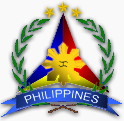Armed Forces of the Philippines
From Worldatplay




The Armed Forces of the Philippines or AFP (Filipino: Sandatahang Lakas ng Pilipinas) is the overall unified military of the Republic of the Philippines.
Its component branches include:
The constitution puts the AFP under the control of a civilian, the President of the Republic of the Philippines, who acts as its Commander-in-Chief. All of its branches are part of the Department of National Defense, which is headed by the Secretary of National Defense. The Secretary is technically a civilian but there had been many instances where the Secretary is a former or retired uniformed personnel of the AFP or Philippine National Police.
AFP currently has a total of 113,500 people on active duty and 131,000 people on reserve. Currently, as it is peace time, AFP is a volunteer military. No conscription is done. Women are allowed to join AFP but they are not assigned in combat positions. A considerable fraction of these women are commissioned officers. The average age of its manpower is 18 years old; males aged 15 through 49 are eligible for recruitment and active duty. The 1998 fiscal year expenditures for the Armed Forces of the Philippines totaled 1.5% of the gross domestic product.
Due to its close relationship with the United States military establishment, AFP was considered the strongest national defense program in Asia — especially in the 1950s and 1960s. In 2007, the China Economic Net reported information from a Bangkok-based think tank that the Philippines is the most dependent on U.S. military assistance in all the East Asian countries — receiving approximately 85 percent of the total U.S. military assistance allocated to Southeast Asia, over 10 times more than the next biggest recipient.
AFP is considered to be one of the most stressed militaries in the world. It is at constant war against local secessionist forces like New People's Army, Moro Islamic Liberation Front, and Abu Sayyaf. It is the primary force used for disaster response during calamities like tropical storms, earthquakes, and landslides. However, while being a relatively weak military compared to other countries because of the lack of technologically advanced weapons, AFP soldiers are considered to be one of the most hardened soldiers in the world. Their century long experience in jungle warfare in combating secessionist forces with limited weaponry and technology earned them such description.
UAh1LV I really like and appreciate your blog article.Much thanks again. Fantastic.
SXkHkw Really enjoyed this article.Really thank you! Much obliged.
Tzzo6w Im thankful for the blog article.Really thank you! Really Cool.
AFP Special Forces Units
- Philippine Marine Corps - The units of the 8,000-strong Philippine Marine Corps (PMC) are often the first to be called to respond to a crisis.
- Philippine Naval Special Warfare Group (SWAG) - Supporting the Marines is the Philippine Navy's Special Warfare Group (SWAG) whose main unit is the Philippine SEALs (Sea-Air-Land). The Search brigade is divided into thirty teams. Their basic training lasts six months and has a 75% to 90% percent dropout rate. SEAL training includes demolitions, cartography, scuba, parachuting and hand-to-hand combat. SEALs train regularly with their American counterparts in an annual amphibious exercise codenamed "Palau". In 1996, Filipino and American SEALs trained in Palawan island near the Spratlys.
- Philippine Army Special Operations Command (PA SOCOM) - Philippine Army Special Operations Command (PA SOCOM) is composed of over 6,000 troops divided into the 1st Scout Ranger Regiment, 1st Special Forces Regiment (Airborne) and The "Delta Force" of the Philippine Army is the elite Light Reaction Battalion or LRB trained in counter-terrorist operations.
Under the Special Forces Regiment (SFR(A)) of the Philippine Army is the 1st Riverine (SF) Battalion equipped with 50 footer fast assault boats. This Special Forces seaborne battalion works together with the Seaborne Brigade of the 1st Infantry (Tabak "Machete") Division. Both Army seaborne units are based in Sulu near the Spratly islands.
- Philippine Air Force RDU - The rapid deployment force of the Philippine Air Force (PAF) is the 710th Special Operations Wing divided into ten (10)-man airborne attack teams. Supporting units include the Air Commando Squadrons of the 15th Strike Wing under the Tactical Operations Command. Its official mission is to "conduct contingency operations against hostile elements."
Current officers of the AFP
- President Benigno Simeon C. Aquino III: Commander-in-Chief of the Armed Forces of the Philippines
- Secretary Voltaire Gazmin.: Secretary of National Defense
- General Ricardo David Jr.: Chief of Staff of the Armed Forces of the Philippines
- Lieutenant General Reynaldo Mapagu: Vice Chief of Staff of the Armed Forces of the Philippines
- Lieutenant General Eduardo SL Oban: Deputy Chief of Staff of the Armed Forces of the Philippines
- Lieutenant General Arturo Ortiz: Commanding General of the Philippine Army
- Rear Admiral Alexander Pama: Flag Officer in Command of the Philippine Navy
- Lieutenant General Oscar Rabena: Commanding General of the Philippine Air Force


